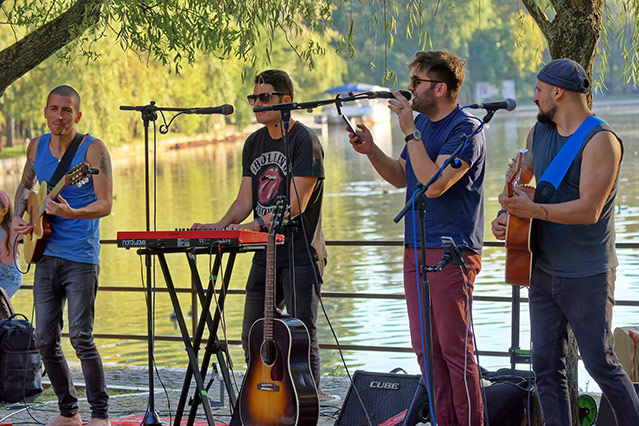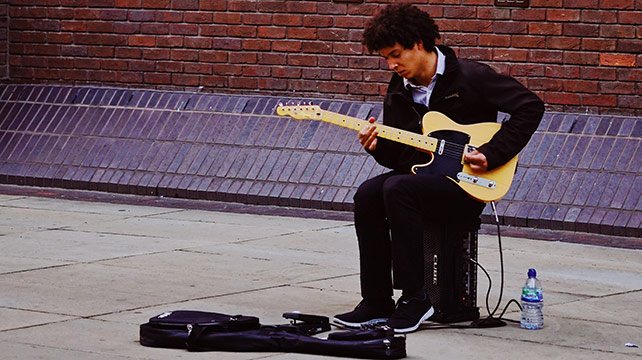Electric guitars are one of the most popular musical instruments in the world and are very versatile, too, which is why they’re used in various genres worldwide. However, they need a power supply to produce sound at audible volumes, which is why even for a more intimate performance where an acoustic guitar could easily be heard, you still need an amp that requires power to run.
If you’re considering playing an outdoor gig, you might wonder how you would power the guitar amp. Fret not! This article is going to be a detailed discussion on:
- how to power your amp outdoors
- other ways to play an electric guitar outdoors
- how to power your effect pedals
There are several ways to power a guitar amp outdoors. You can power it with your car battery using a small inverter to convert 12VDC to 120/240VAC, or you can use a small gas generator which is very silent these days. If you want to play the guitar in a more intimate setting or with lower volume, like busking, you can get a portable guitar amp that runs on batteries.
How To Power a Guitar Amp Outdoors?
Talking about the outdoors usually means somewhere far from our or our friends’ homes. If it were your backyard, you wouldn’t be asking this question, would you?
While guitar amps are made to withstand extreme outdoor weather easily, we wouldn’t recommend getting your tube amp outside in such conditions. As for most solid-state amps – they’ll be okay in hot, cold, or even humid weather as long as it doesn’t rain. Get a large plastic sheet or cut a plastic bag to make a small “raincoat” for the amp if you suspect an incoming rain.
Let’s take our discussion back to how you can power your guitar amp outside.
Power the Amp With Your Car Battery
One of the most commonly used methods is to power the amp with your car battery. For this, you’ll need a portable 12V pure sine-wave inverter that runs off your car battery and supplies you with 120V/240V AC power. For a moderately powerful amp (about 100 watts), you will need a 500-watt inverter which costs around $70. For higher wattage amps, you can go for a higher-powered inverted, but do remember that such amps will drain the car battery fairly quickly.
Remember to check your guitar amp’s power rating before purchasing an inverter. For example, in my research, the Fender Rumble 100-watts guitar amp draws about a peak of 310 watts which should work perfectly fine with a 500-watts inverter. If your amp mentions the power input power rating in amperes, you can determine the wattage by multiplying it by 120/240 (according to the voltage rating). And remember to get a pure sine-wave inverter; otherwise, your amp will probably produce a humming sound due to the power supply.
I recommend powering on the car’s engine while you play the gig, so the battery doesn’t run out. A standard car battery rated at 75AH (ampere-hour) will probably be able to run a 500w inverter at full load for about an hour. The above Fender Amp would likely run for about 2 hours, give or take, until the battery runs out. So, depending on your guitar amp’s wattage and the duration you’re playing, you would want to either keep your car’s engine running or start it for 15-20 minutes into the performance.
If playing outdoors is something you’ll be doing regularly, you would also want to get a charger to recharge your car battery when you get home. This will keep the battery in its best condition for longer.
Rent / Buy a Silent Gas Generator

A straightforward way to power the guitar amp is with a silent gas generator. The caveat is the good ones that produce a pure sine-wave and are silent are costly to buy. A decent 2000W portable, silent generator would set you back by around $350-$400. If you’re going to play a lot outside, you can get one; otherwise, try looking for someone in your area who would rent these.
One significant advantage of gas generators is that they can provide a lot of power. You could easily run a decently powered guitar amp (100W), a bass amp (200W), a keyboard/synthesizer, and a pedalboard with a 2000-watts generator. And most silent generators are indeed very quiet and make less noise than a car’s engine, so your audience shouldn’t be able to hear the generator amidst your performance.
I wish to reiterate that you should always look for a decent generator that outputs a pure sine wave with as little distortion as possible. Cheaper ones with lots of distortion can mess with the sensitive electronic components in a guitar amp besides producing a humming sound.
A great way to find out if the power output is distortion-free is to plug in your guitar amp without hooking up the guitar, roll the volume control to very high and listen for any humming or buzzing. If there is a static sound (which is not there when you power it with your home power supply), it wouldn’t be wise to use this inverter/generator.
Ask Someone To Let You Plug Your Extension Cable
You would be surprised how many people and even businesses are eager to help if you’d ask them nicely. Offer to pay them if they would like that; some people wouldn’t take the money, in which case you can buy them a drink or something. For this, you’ll need a long extension cord which generally has only one output outlet. You can get a second shorter power strip with several outlets to connect your amp and other gears, like the pedalboard.
Be careful not to place the strip or the outlet on the floor or anywhere they might get stepped on or come in contact with people. And always carry electrical tape in case the wiring gets scratched or cut.
Ways to Play Electric Guitar Outside
If you wish to play your guitar outside for small, intimate gigs like busking, etc., you have other methods that will cost you less money and would be more portable and much less hassle.
Get a Battery Powered Guitar Amp

There are various battery-powered amps available, from the small 3-watt practice amps to bigger 50-watt amps that can run on battery power. If you want something for busking, you can get a smaller 10-watt amp with a battery compartment where you can put alkaline or rechargeable batteries to play. Most of these also take either 9V or 12V DC power supply. You can also power a 12V portable amp with your car battery. Since these amps don’t draw too much power, you’ll be able to play for hours when connected to your car’s battery. These portable amps also come with many features, including inbuilt effects and the ability for amp modeling.
The sound quality of these portable amps is good, and decent ones compare well to bigger full-fledged guitar amps. However, the volume is usually significantly less due to the lower wattage. Therefore, I recommend them only for busking and campfire “performances.”
Play Through Portable Speakers
Nowadays, almost everyone has these smaller portable, Bluetooth speakers that run on batteries. The good news is you can use them for playing guitar, for which you’ll only need a small, cheap headphone amp that costs around $30. typically, these micro-amps plug directly into the guitar’s output jack, and you’ll only need an auxiliary cable to connect the micro-amp to your portable speakers.
The sound output would be passable at best because the drivers in most of these speaker systems are tiny and not meant for guitar playing. Larger speaker systems with better, bigger, and separate drivers should give a decent sound output with loud enough volume.
How To Power Your Guitar Pedals?
Effect pedals are easier to power as most of them can be run on batteries, through an adapter, or a pedalboard. If you’re using more than a couple of pedals, use a pedalboard and power it with the inverter or generator. But if you’re using a couple of pedals, you can also run them with batteries. Do remember, some effect pedals drain more power than others. Always check the power rating to know how long they’ll run on batteries. You don’t want your effect pedals dying mid-performance.
Final Thoughts
Many people like to play the guitar or perform outdoors, but a lack of power outdoors sometimes stops them from doing that. In this article, I tried to explain how outdoor performers (doing small gigs) and guitarists power their amps. Whichever method you choose, be sure to read the details I provided that would help you find a power supply that can efficiently handle your guitar amp without causing any issues.
A lot of people fail to realize that a car and its battery can act as a decent power supply for guitar amps as long as you’re using a high-quality inverter to step up the voltage. It may not be very efficient, but it is undoubtedly very convenient.
I hope this article helped you find a way to power your guitar amp outdoors so that you can play outside to your heart’s content!


